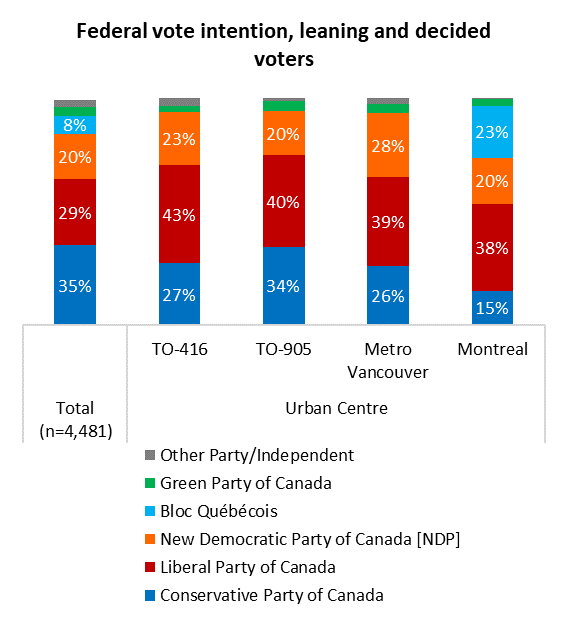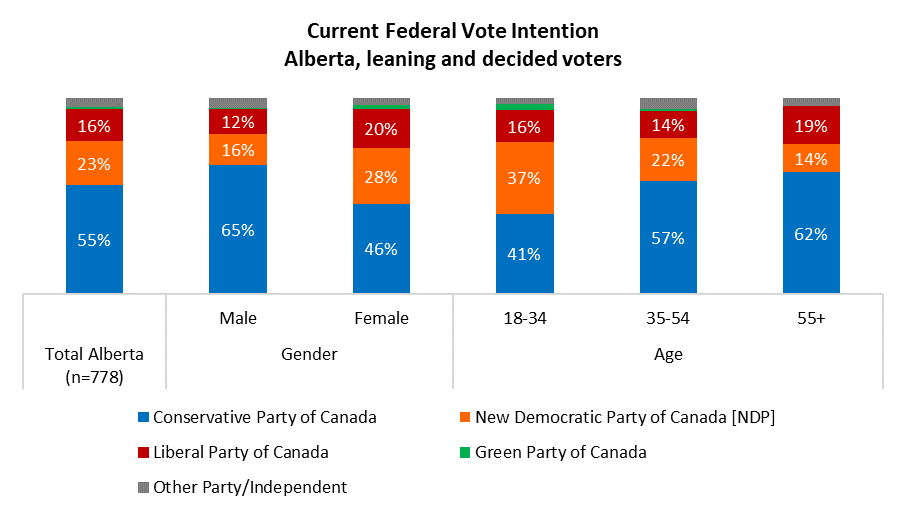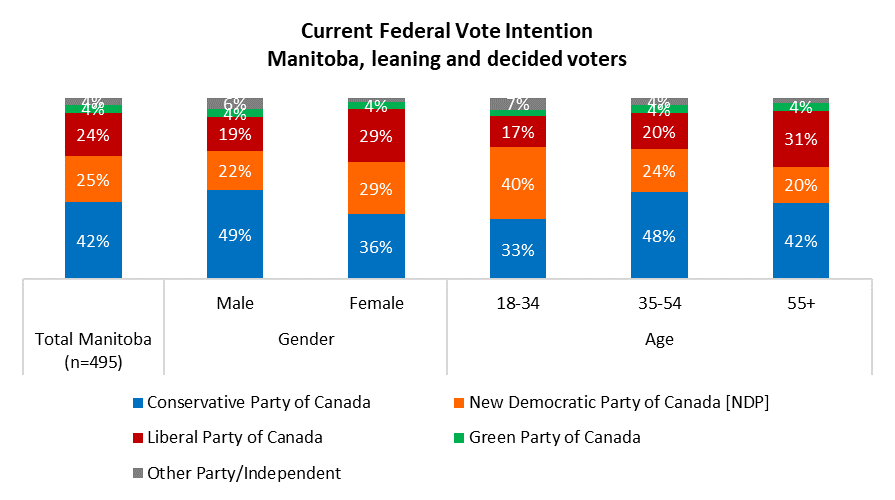Federal Vote Deep Dive: Despite national lead, major urban centres represent a significant obstacle for CPC

Liberals hold significant advantage in Montreal, Toronto, Vancouver; CPC dominate in Albertan metros
March 30, 2023 – Members of the Liberal government will embark on a cross-country tour to promote the benefits of its new budget, released on March 28, which includes new supports for low- and modest-income families in the form of GST and grocery rebates, and expanded dental coverage. As Liberals meet with constituent communities from coast-to-coast, they do so with ground to gain in current vote intention, and support to re-gain in some major urban spaces.
Analysis from the non-profit Angus Reid Institute finds the Conservative Party theoretically on a path to forming government if an election were held soon. A persistent hurdle, however, continues to be the party’s lack of resonance in Toronto, Montreal and Vancouver.
The opposition CPC hold a six-point lead in vote intention nationally. But in those three largest metropolitan centres in the country, the Liberals maintain a significant advantage. Success in these spaces has been of utmost importance in propelling the Liberals to governance.
In the GTA, two-in-five say they would support the Liberals if an election were held – 40 per cent in the 905 and 43 per cent in the 416. Both of these represent a significant drop in support compared to 2021 when 52 per cent supported the party in the Toronto core and 48 per cent did so in the 905. While the Liberals are down, the CPC is not necessarily up. The opposition has gained just two points in the 416 and three in the 905, both within margin of error for these sub-regions. New Democrats gain the most in these new data, though much of that party’s support is contingent on less reliable voters younger than 35.
Quebec, too, is a source of some Liberal chagrin and CPC frustration. The LPC hold an advantage in Montreal, but nowhere else there. Current vote intention for the Liberals in Greater Montreal, like much of the country, is down. Conversely, the CPC has made no significant gains in Quebec overall (+2).
About ARI
The Angus Reid Institute (ARI) was founded in October 2014 by pollster and sociologist, Dr. Angus Reid. ARI is a national, not-for-profit, non-partisan public opinion research foundation established to advance education by commissioning, conducting and disseminating to the public accessible and impartial statistical data, research and policy analysis on economics, political science, philanthropy, public administration, domestic and international affairs and other socio-economic issues of importance to Canada and its world.
Introduction
Eighteen months separated from the 2021 federal election that propelled it to power, the Liberal minority government and Prime Minister Justin Trudeau govern the country with little – but not zero – election speculation because of its confidence-and-supply agreement with the NDP. However, that agreement, which could see the Liberals hold power until 2025, is not ironclad.
On the eve of the one-year anniversary of the deal – and prior to the federal government’s budget that included an expansion of dental care, a policy concession won by the NDP in the agreement – NDP leader Jagmeet Singh said he was “not satisfied” with the arrangement because he would prefer to be prime minister. The NDP can depart the agreement at any time. So could the Liberals should they decide they want to receive another mandate from the voting public.
Thus, despite this period of relative electoral stability for the minority government, an election remains a possibility. In the year and a half since the country last voted for its federal government, there have been many policies, scandals, issues, and developments which factor into the minds of potential voters across Canada. Below is an in-depth, cross-country, regional analysis of the most recent vote intent data from the Angus Reid Institute.
British Columbia
Past federal election results:
2015: Liberal 35%, CPC 30%, NDP 26%
2019: CPC 34%, Liberal 26%, NDP 24%
2021: CPC 33%, NDP 29%, Liberal 27%
In British Columbia, Metro Vancouver continues to be the strongest source of support for the governing Liberals. All 15 of the Liberals’ B.C. seats came from the region in 2021, while being shutout in the rest of the province. Vote intention in that region is largely unchanged compared to the previous federal election. Deficits elsewhere have Canada’s westernmost province still leaning toward the federal Conservatives overall. The CPC garnered 33 per cent of the vote in the 2021 federal election – a proportion largely unchanged and a result boosted by strong support in the B.C. Interior:

Women in B.C. offer similar levels of support for both the NDP (33%) and the Liberals (30%), while one-in-four would vote for the CPC. Meantime, two-in-five men would vote for the CPC:

Alberta
Past federal election results:
2015: CPC 60%, Liberal 25%, NDP 12%
2019: CPC 69%, Liberal 14%, NDP 12%
2021: CPC 55%, NDP 19%, Liberal 16%
It likely comes as no surprise that the Conservative Party receives immense support in Alberta. Each of the past two elections have seen the CPC carry nearly every seat in the province, bolstered by a significant advantage in Calgary and Edmonton, as well as an overwhelming majority of voters outside of those two major urban centres:

*Previously released federal vote intention data from Alberta has been updated due to a technical issue misassigning one riding to other AB instead of Edmonton
The gender divide noted in most of the country is evident to a lesser extent in Alberta. While men prefer the CPC at rates higher than women, that party is the clear choice for both. Any success in a future federal election in Alberta for the NDP and Liberals will be contingent on an active youth vote, as the CPC is least popular among 18- to 34-year-olds:

Saskatchewan
Past federal election results:
2015: CPC 49%, NDP 25%, Liberal 24%
2019: CPC 64%, NDP 20%, Liberal 12%
2021: CPC 59%, NDP 21%, Liberal 11%
The prairies of Saskatchewan are home to the most unified set of would-be voters in the country. Three-in-five residents and at least 48 per cent in every major region would support the CPC if an election were held. The NDP receives significant support – amounting to three-in-ten voters – in both Regina and Saskatoon, but the Conservative Party’s supremacy is largely unquestioned here:

Across gender and generations, little variance is notable in Saskatchewan. At least half of all groups say the CPC would receive their vote:

Manitoba
Past federal election results:
2015: Liberal 45%, CPC 37%, NDP 14%
2019: CPC 45%, Liberal 27%, NDP 21%
2021: CPC 39%, Liberal 28%, NDP 23%
Although two-in-five Manitobans voice support for Conservatives, there are more seats up for grabs in that province than in neighbouring Saskatchewan. While all 14 seats in the 2021 election in Saskatchewan went to the opposition, half of Manitoba’s 14 seats were split by the NDP and Liberals. A divided populous in Winnipeg suggests this may again be the case in a future election, as 32 per cent in the metropolitan area prefer the CPC and NDP alike, while 28 per cent prefer the Liberals:

Competition for votes in Manitoba will be considerable when the next election is called. Female voters offer at least 29 per cent support for all three major parties, while older voters, those who tend to be most likely to show up on Election Day, offer significant support to both the Liberals and CPC:

Ontario
Past federal election results:
2015: Liberal 45%, CPC 35%, NDP 17%
2019: Liberal 42%, CPC 33%, NDP 17%
2021: Liberal 39%, CPC 35%, NDP 18%
The Liberal Party’s minority government position has been founded on strong, but fading, results in Ontario since 2015. The Liberals have seen their vote share drop by three points in each of the last elections and are at risk of losing more ground in a future one. Currently 34 per cent say they would vote for the Liberals, drawing much of that support from Toronto, where the party is still the top choice. The CPC, however, is favoured in much of the rest of the province.
In the 416 region, the Liberals received slight majority support in 2021 (52%). Vote intention has the party down nine points now, with the NDP gaining most (+5). In the outskirts of the 905, the Liberals are down eight points from 2021 results, though support for the CPC is largely unchanged at 36 per cent (+2):

Ontarians over the age of 54 are divided evenly between both the incumbent Liberals and the opposition Conservatives. As is the case in most of the country, the CPC is the top choice among men and the Liberals are the top choice for women. While the NDP has made vote-intention gains in Toronto, it is worth noting that these are generated from younger supporters who tend to be less reliable on Election Day:

Quebec
Past federal election results:
2015: Liberal 36%, NDP 25%, BQ 19%, CPC 17%
2019: Liberal 34%, BQ 32%, CPC 16%, NDP 11%
2021: Liberal 34%, BQ 32%, CPC 19%, NDP 10%
The Liberal Party has received support from approximately one-in-three Quebecers in each of the last three federal elections. This suggests a drop in support currently, with 28 per cent saying they would vote for the Liberal candidate in their riding if an election were held. Montreal remains a Liberal stronghold, but the province is defined by multiple competitive regions, with the Liberals, Bloc Québécois and CPC all generating would-be support:

Older voters in Quebec favour the BQ by 11 points over the Liberals, while the province is much more divided between age and gender groups than most other regions of the country:

Atlantic Canada
New Brunswick past federal election results:
2015: Liberal 52%, CPC 25%, NDP 18%
2019: Liberal 38%, CPC 33%, NDP 9%
2021: Liberal 42%, CPC 34%, NDP 12%
Nova Scotia past federal election results:
2015: Liberal 62%, CPC 18%, NDP 16%
2019: Liberal 41%, CPC 26%, NDP 19%
2021: Liberal 42%, CPC 29%, NDP 22%
P.E.I. past federal election results:
2015: Liberal 58%, CPC 19%, NDP 16%
2019: Liberal 44%, CPC 27%, NDP 8%
2021: Liberal 46%, CPC 32%, NDP 9%
Newfoundland and Labrador past federal election results:
2015: Liberal 65%, NDP 21%, CPC 10%
2019: Liberal 45%, CPC 28%, NDP 24%
2021: Liberal 48%, CPC 33%, NDP 17%
If any region of the country represents the challenges the Liberals face in forming government for a fourth consecutive election, it is Atlantic Canada. Gone are the runaway victories that the Liberals enjoyed in 2015, replaced with a population divided between Liberal and Conservative options. The Liberals strongest support is noted in Prince Edward Island, which offers just four seats in the House of Commons.

Survey Methodology:
The Angus Reid Institute conducted an online survey from March 6-13, 2023 among a representative randomized sample of 4,899 Canadian adults who are members of Angus Reid Forum. For comparison purposes only, a probability sample of this size would carry a margin of error of +/- 1 percentage points, 19 times out of 20. Discrepancies in or between totals are due to rounding. The survey was self-commissioned and paid for by ARI.
For detailed results by age, gender, region, education, and other demographics, click here.
To read the full report, including detailed tables and methodology, click here.
Image – Jochem Raat on Unsplash
MEDIA CONTACT:
Shachi Kurl, President: 604.908.1693 shachi.kurl@angusreid.org @shachikurl
Dave Korzinski, Research Director: 250.899.0821 dave.korzinski@angusreid.org


